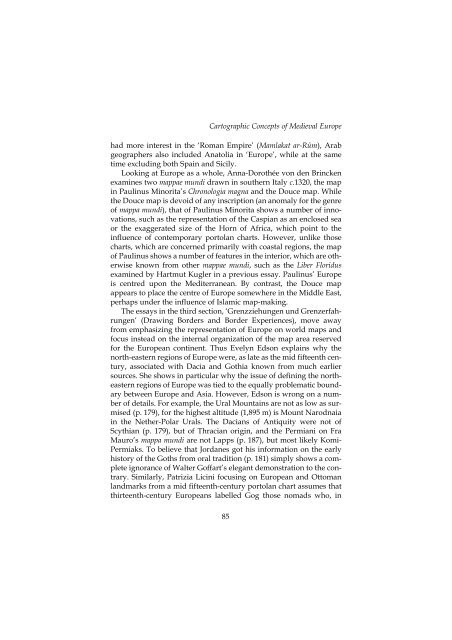Download - German Historical Institute London
Download - German Historical Institute London
Download - German Historical Institute London
You also want an ePaper? Increase the reach of your titles
YUMPU automatically turns print PDFs into web optimized ePapers that Google loves.
Cartographic Concepts of Medieval Europe<br />
had more interest in the ‘Roman Empire’ (Mamlakat ar-Rūm), Arab<br />
geographers also included Anatolia in ‘Europe’, while at the same<br />
time excluding both Spain and Sicily.<br />
Looking at Europe as a whole, Anna-Dorothée von den Brincken<br />
examines two mappae mundi drawn in southern Italy c.1320, the map<br />
in Paulinus Minorita’s Chronologia magna and the Douce map. While<br />
the Douce map is devoid of any inscription (an anomaly for the genre<br />
of mappa mundi), that of Paulinus Minorita shows a number of innovations,<br />
such as the representation of the Caspian as an enclosed sea<br />
or the exaggerated size of the Horn of Africa, which point to the<br />
influence of contemporary portolan charts. However, unlike those<br />
charts, which are concerned primarily with coastal regions, the map<br />
of Paulinus shows a number of features in the interior, which are otherwise<br />
known from other mappae mundi, such as the Liber Floridus<br />
examined by Hartmut Kugler in a previous essay. Paulinus’ Europe<br />
is centred upon the Mediterranean. By contrast, the Douce map<br />
appears to place the centre of Europe somewhere in the Middle East,<br />
perhaps under the influence of Islamic map-making.<br />
The essays in the third section, ‘Grenzziehungen und Grenzer fah -<br />
rungen’ (Drawing Borders and Border Experiences), move away<br />
from emphasizing the representation of Europe on world maps and<br />
focus instead on the internal organization of the map area reserved<br />
for the European continent. Thus Evelyn Edson explains why the<br />
north-eastern regions of Europe were, as late as the mid fifteenth century,<br />
associated with Dacia and Gothia known from much earlier<br />
sources. She shows in particular why the issue of defining the northeastern<br />
regions of Europe was tied to the equally problematic boundary<br />
between Europe and Asia. However, Edson is wrong on a number<br />
of details. For example, the Ural Mountains are not as low as surmised<br />
(p. 179), for the highest altitude (1,895 m) is Mount Narodnaia<br />
in the Nether-Polar Urals. The Dacians of Antiquity were not of<br />
Scythian (p. 179), but of Thracian origin, and the Permiani on Fra<br />
Mauro’s mappa mundi are not Lapps (p. 187), but most likely Komi-<br />
Permiaks. To believe that Jordanes got his information on the early<br />
history of the Goths from oral tradition (p. 181) simply shows a complete<br />
ignorance of Walter Goffart’s elegant demonstration to the contrary.<br />
Similarly, Patrizia Licini focusing on European and Ottoman<br />
landmarks from a mid fifteenth-century portolan chart assumes that<br />
thirteenth-century Europeans labelled Gog those nomads who, in<br />
85













